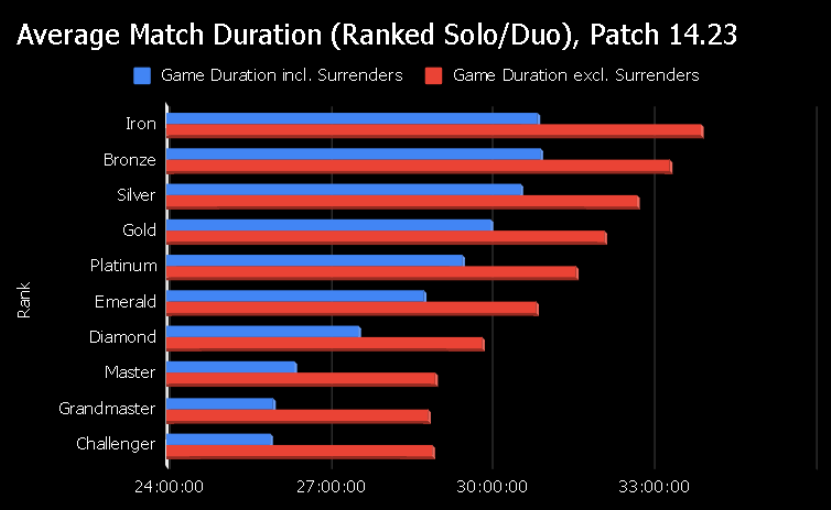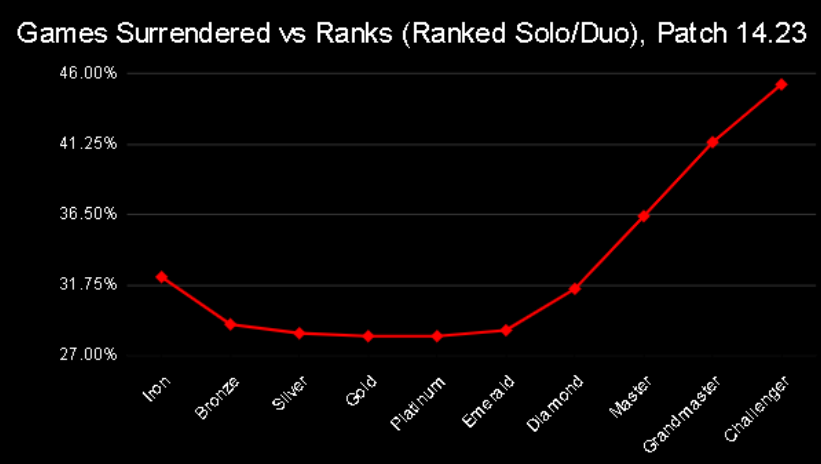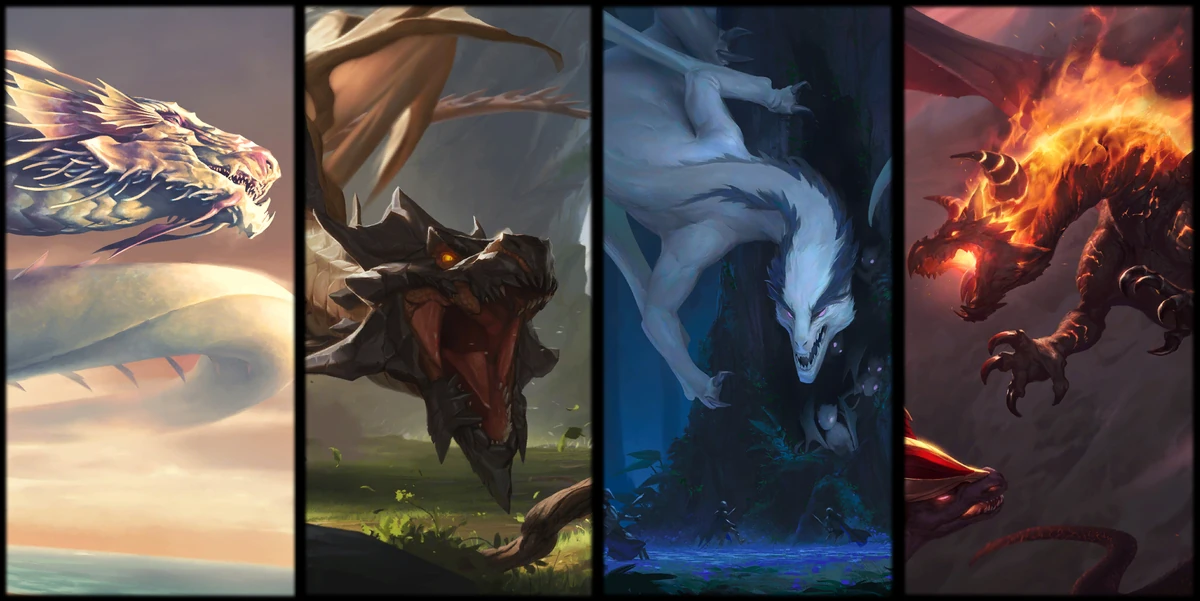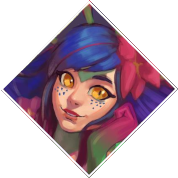
If you’re curious about exploring the dynamics of lower-ranked gameplay, our Iron-ranked accounts offer an ideal starting point. These accounts let you experience a more relaxed, experimental environment while refining your skills.

The reasons for this are a little unclear. One hypothesis is that more games end in surrender at higher elo. In the chart, you'll notice the difference between games with and without surrenders tends to get bigger. This matches up with the statistics on surrenders.

Gold and Platinum players tend to surrender the least on average, at 28.3% of games, and Challenger players tend to surrender the most, at 45.3%, almost half of their games.
This is an extremely steep and consistent increase. The reasons for this are pretty simple, though. Higher elo players make less mistakes, and thus, comebacks generally tend to become less and less likely as you climb the ranks.
Even when accounting for surrenders, though, we see that higher elo players still tend to have slightly shorter matches. It's the same reason for why comebacks are less likely to happen, though.
Players in higher ranks close out games faster and more decisively than those in the lower ranks. Objectives and towers tend to be taken earlier, and people spend more time farming and scaling, leading them to get their powerspikes sooner than later.
In general, trying to have shorter games is actually not bad advice, if you're trying to climb. Lower skill players struggling to close out games is exactly the reason why champions like Nasus and Kayle have an easier time in lower elo.
This doesn't necessarily mean that picking a scaling champion will lead to longer games, though. However, picking a strong early game champion that falls off hard, like Pantheon, Elise or Draven, or having a comp mostly composed of similar early-game picks, will lead to you either winning because you closed out the game quickly, or to you losing to a surrender.
In summary, choosing scaling champions doesn't seem to influence average game length, but choosing early game champions does.
Statistically, the team who took first blood has a winrate of 57%. Taking first dragon gives that team a 60% winrate. The team who takes first baron is at a polarizing 80% winrate. The first team who takes an inhibitor has an astounding 90% winrate.
Teams that take the initiative on objectives earlier increase their chances to win sooner, leading to shorter games.
An average League of Legends game typically lasts between 30 to 35 minutes. Being more or less likely to surrender doesn't actually seem to cut much of your average game time either, interestingly enough. About 2 minutes on average per game.
Even though higher elo players tend to play shorter and shorter games, this doesn't seem to be the case for professional games. Matches in pro-play tend to hover around 30-35 minutes, and are seeing a trend of becoming longer as of late.
Keep in mind that the pro-play meta tends to be quite different than the soloqueue meta, even in Challenger. Proplayers tend to be more cautious, and the current meta rewards small but safe gains over the course of a longer game. Comebacks are still rare, but specifically because being given the opportunity to make a play so huge it turns the game around is rare. There's simply less mistakes to exploit and abuse to make a comeback, less team fights to turn around, and less chances to catch up in gold.
Proplay has had instances of extremely short match lengths, though.
The shortest game ever in the pro scene was TopHard Esports (TH) vs Another Troll Team (ANT) in the LTL 2019 Opening, with a time of 07:35. ANTs ADC had issues joining the game, and wasn't able to solve the issue under the given pause time. In a controversial move, the game referee decided to continue and start the game as if nothing had happened.
The game quickly descended into ANT's jungler giving up on the game, followed by their toplaner. 5 minutes in, the entire team decided to open every game and allow TH to win with a final time of 07:35.
The longest game ever in the pro scene was SKT T1 vs Jin Air Green Wings (JAG). The match, the sixth game in the LCK 2018 Spring tournament, lasted for a final time of 94:37. JAG won the best-of-three match 2–1 in a game fought in the bottom lane, with JAG's Park “Teddy” Jin-seong and Kwon “Wraith” Ji-min taking the fight to SKT. It also marked the first time anybody ever hit 1000 CS in an esports game.
Funnily enough, the entire game only had a total of 24 kills in it.
League of Legends games have become noticeably shorter over the years. In Season 5, the average game in Gold elo used to be 34:40, compared to 30:00 today. In Challenger, game length dropped from 31:00 all the way down to 25:54. This is not due to players becoming better over the years, or a change in the strategies employed by them. This is an intentional effect of a number of small changes, that have been happening as early as Season 2.

The main point to these changes, at the start, was to differentiate the game from DoTA. However, as these changes rolled out, it became clear that the playerbase simply preferred the faster gameplay. Shorter games, over time, became what League was known and played for in contrast with DoTA and other MOBAs.
Summoner's Rift has undergone a number of changes since its initial iteration. Let's start with some of the most basic changes: the addition of more neutral monster camps. Each side of the map added the Wight camp in Season 3, which would eventually become the Gromp camp.
Having more monster camps presents more income for junglers, and later on, for any champion who might happen to be walking past the area where the camp spawns. Even though the Wight and Gromp were the camps worth the lowest gold in their respective times, going from 3 to 4 camps in each quadrant of the jungle meant a 25% increase in jungler income.
The second camp meant to make games faster were Rift Scuttlers, or just scuttles. It scales up very quickly in gold value throughout the game, starting at 55 gold and exceeding 80 gold by the 10 minute mark. At the time of their introduction, the gold was actually higher, at 70 gold at level 1 and 100 gold at 10 minutes, another big increase to jungler income.
Scuttles became so valuable that they'd commonly serve as the first source of conflict between jungers, which paved the way for a trend of early game-centric junglers that would be able to snowball off of bullying the other jungler from both scuttles, and using the speed buff to gank and rotate around the map faster.
Rift Herald is the most obvious addition to make the game faster. Back in earlier versions of League of Legends, winning a midgame teamfight would often mean claiming a tower. If your side wins the same midgame teamfight and has the Rift Herald in tow, it's easy to claim two towers while the other team is reviving, sometimes three towers. It wasn't hard to see inhibitors falling prior to 20 minutes during Season 9 because of Rift Herald.

The creation of elemental drakes created the opportunity to add additional bonuses to champions that help to further accelerate winning teams further ahead. The Infernal Drakes are the best example of this, with their percentage bonus to attack damage (AD) and ability power (AP), and the amount of that bonus was increased even further in Season 9.
In their introduction, Infernal Drakes would grant a whopping 10% additional AP and AD for the first one, up to a maximum of 24% with three Infernal Drakes.
Other dragon types were useful in their own fashions too, whether it's the Mountain Drake making it easier to kill towers and Baron, or the Ocean Drake providing health and mana regen to keep pushes going longer, or the Cloud Drake for faster movement around the map. If everyone in the game is moving faster, well, that's the most basic way possible to have shorter games.
Dragons also spawn faster than ever before, every 5 minutes as opposed to every 6 minutes, creating more opportunities to stack up these champion bonuses and make it more difficult for a losing team to stall out the game. If a game stretches too far into the late game, the addition of the Elder Dragon provides another way for a leading team to polish off their opponents and close out the game. The Elder Dragon + Baron combination into a push or team fight is designed to be almost impossible to stop; the days of CLG EU stalling out a game to 70 minutes with endless wave clear are long since dead and buried. It was created with the intention that a winning team could not be stalled out by another team with really great waveclear.
The Baron buff itself was also changed, compared to the older seasons. It still grants 40 AD and AP, but it didn't always grant a buff to minions. The current Baron buff makes it very difficult to stop pushes, especially with cannon minions which can remain outside of tower range and continue to take potshots at structures. Clearing the buffed Baron minions is hard and risky, so it's far harder to stall out a Baron push than it used to be.
Minions themselves do more damage these days than they used to. After Season 9, they started appearing in every other wave after 15 minutes, and then on every wave after 25 minutes.
The Speed Shrines that appear after killing the Rift Scuttlers are the most obvious example of a map change, but Blast Cones also generally made moving around the map easier. The net effect is the same thing that we've been seeing again and again: faster movement leads to shorter games. No one of these changes were huge on its own, but the net effect of so many small changes to the Rift is unmistakeable.
Items over the years have been moving towards being more gold efficient. Items have more stats in them, do more things, or have more utility for a lower amount of gold. 15 minutes today is considered "late" for building Rod of Ages, for example. The general rule in Season 2 and 3 for RoA was 20 minutes, though. It's even cheaper nowadays, to boot.
On top of that, runes have become a more important part of your early game, or of your entire game, even. Running a full AP rune page with the older rune system would result in 35 AP, which would be considered somewhat high back then.
The then-new Conqueror rune, however, translated 20% of damage against enemy champions into true damage. Electrocute would add 30-180 damage to trades. Even the non-keystone runes had, and still have, a lot of power built into them.
Having so many strong options in the different rune trees balances them out with eachother, but that doesn't offset the total increase in champion power level for the wider game.
Whereas in classic League of Legends there was a real need to manage health and mana as resources, the current version of the game rarely puts players in a situation where players find themselves out of either, unless they've committed a mistake.
There's simply more sustain in the game in general, removing the need for "healbot" supports like Soraka and Sona, or the lane strength of champions that were designed around out-sustaining your opponent, such as Vladimir. Champions generally have higher base health and mana regen than previous seasons. Potions are cheaper and more accessible, runes and items now grant more regen or lifesteal, jungle pets grant all junglers high sustain, Ocean drakes grant sustain, and then you've got honeyfruits in the jungle and.. you get the picture. If you're playing the game right, and you're not making a ton of mistakes, you shouldn't find yourself out of mana or low on health too often.
Mana costs are also lower across the board. Blitzcrank was somewhat infamous for only being able to use his Rocket Grab twice before he ran himself out of mana back when he was released, and many players would open with a Sapphire Crystal for higher max mana because his base mana was so low. Nowadays, pretty much everybody gets a few tries at hitting their abilities. Mana problems are relative in modern League of Legends. You may be low on mana in lane because your current opponent has more efficient uses for their mana (or uses no mana at all), but you may be considered mana efficient in an entirely different matchup. Mana problems only arise when you are unable to match your opponent's waveclear, rather than from your champion doing what they're supposed to do.
The general intention of these changes is pretty solid, though. They haven't made mana or health, or even recall timers, irrelevant. But time spent recalling and walking back to lane is time you spend doing basically nothing. If you need to recall several times before level 6 for mana or health, naturally this is going to lead to games being longer.
Although explaining how League of Legends became a faster game over the years takes a bit of history-reading, explaining why it became a faster game takes one sentence:
It makes more money, and players find it fun.
Simpler games that take less time to pick up simply make more revenue than otherwise harder games, and it is specifically this style of faster gameplay that allowed Riot Games to rake in billions (yes, with a b!) ever since these changes accelerated in 2019.
Regardless, it doesn't seem like many players complained at the time that games were too short. If anything, some of these changes were some of the most heavily supported by the community. Nobody these days would dream to suggest older dragons that would just give your team 200 gold for killing it, or removing rift scuttles.
More than pushing for shorter games, these changes also pushed players to have more things to do during all stages of the game.
The sad drawback of these changes is one that is too fresh on the mind. Surrendering has become more and more common over the years. With there being more things to grab on the map earlier in the game, snowballing became more common. It's not rare to look at the map 10 minutes in and realize you have no control over anything. No dragons, no grubs, no winning lanes. With how important objectives have become, it becomes obvious that you have very little chance of winning the game, at earlier and earlier stages of the match.
The development team noticed this, adding the capability of being able to surrender the match 15 minutes in, if your entire team wishes to. This leads to a culture of "ff15, go next". If you're not at a strong spot 5 minutes in, just surrender.
While it's extremely annoying to see your teammates give up after losing one kill or one dragon in an early fight, then tune out and play with one eye closed for the rest of the game because of it, they might not be exactly wrong. As we've seen before, the team who gets the first kill is 10% more likely to win, statistically.
It may seem obvious that doing well early leads to you being more likely to win the game, but the numbers can be extremely polarizing. Regardless, that's no reason for you to run that 40% chance to win into a 0% chance to win. Go for the mental diff, and understand that the person trying to surrender might not be having the best day right now. It's your chance to mute them and force them to break their losing streak.
League of Legends gameplay, as a whole, ultimately does not suffer from being shorter.
Old League of Legends was tedious, and anyone who was around back in the early days can testify to its problems. Riot hated the concept of support champions when they first emerged and resisted making gameplay changes to accomodate them, thus resulting in long months where 0 CS supports were forced to make due with gold/10 items and function as wardbots with little to no gold to spend. There was no way to queue up for specific roles, and in fact Riot deliberately fought against the concept of having roles at all long after it was obvious from competitive play that they were an inherent part of the gameplay.
The few "nostalgia" private servers for older versions of League that have come out over the years have mostly failed. The truth is, although the artstyle and gameplay is nostalgic, the state of the meta was just not very good. League of Legends is an entirely different game nowadays. It's not better or worse. It's faster, which means it's simply different.
